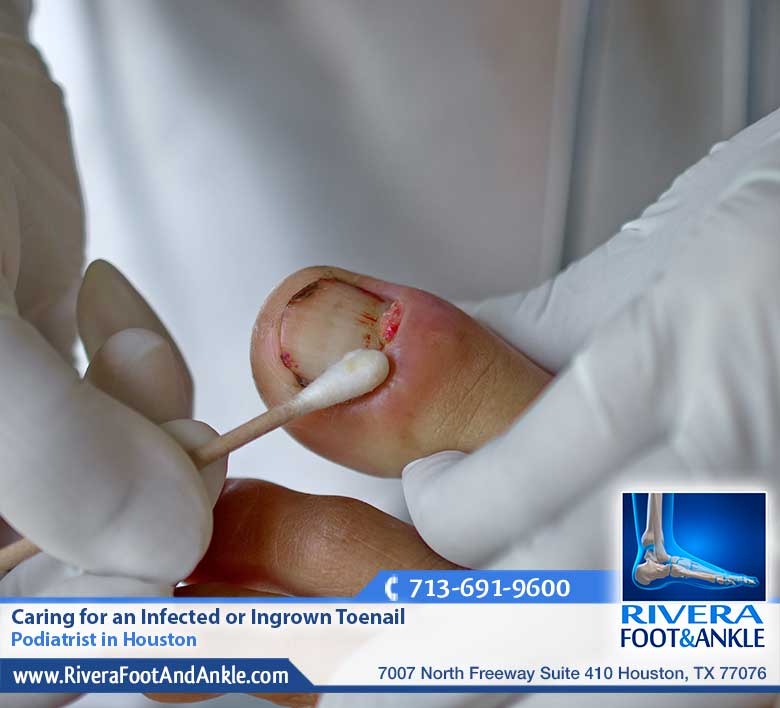
Podiatrist in Houston
Caring for an Infected or Ingrown Toenail
An infected toenail is a slow pain that’s easy to ignore. That is, until it isn’t. Whether the infection is caused by an ingrown nail or because of an injury, it’s hard to ignore when your toenail is a red, infected, sore mess.
If you feel that you have an infection in your toe, you should follow up with a podiatrist or visit your local InstaCare or urgent care clinic as soon as possible.
What causes an infected toenail?
Your toenail can become infected in a number of ways, including fungal infections or even calluses caused by your shoes. One of the most common types of toenail infections is an ingrown toenail. If your toenail is ingrown, it means the edges of your toenail start to grow into the skin next to your toenail. Ingrown toenails can be red and inflamed, sore, and may even be filled with pus.
The most common causes of an ingrown toenails include:
- Cutting your toenail too short or too long
- Toenail injury
- Curved toenails (genetic predisposition)
- Improper footwear (too tight or narrow) that puts pressure on your big toes
- Cutting your toenail improperly (you should cut it straight across without angling the sides of the nail)
- Certain sports and activities like dance, soccer, and skiing
- Poor foot hygiene (not keeping your feet clean and dry)
Infections on your toes may be common if you have diabetes or similar conditions that cause poor circulation or a weakened immune system. Diabetics should check their feet often and have regular appointments with a podiatrist because they may not feel the pain of a toe infection until the problem is severe.
Toenail infection symptoms
An infected toenail comes with pretty specific symptoms. They include:
- Pain with pressure on your toe
- The skin next to your nail being swollen, tender, or hard
- Redness
- Bleeding
- Skin that grows over part of your toenail
- A blister filled with pus (you may not notice a blister, but have large amounts of drainage coming from your toe)
- Yellow toenails that are thick or cracked, suggesting a fungal infection in your toenails
At-home treatment options for ingrown toenails
You can do several things at home to treat an ingrown or infected toenail to help relieve pain and pressure:
- Soak your toe in a warm foot bath with unscented Epsom salt. Mix 1-2 tablespoons of unscented Epsom salts into one quart of warm water and soak your foot for 15 minutes at a time. Do this several times a day for the first few days. Always dry your foot completely after soaking. Soaking your ingrown or infected toe will help relieve the pain and pressure of an infection. It can also help to draw out pus from your toe.
- Keep your feet dry, unless you’re soaking them for treatment.
- Carefully pull skin away from your ingrown toenail with a small nail file that’s blunt and won’t cut your toe. Place a small piece of cotton or dental floss between your nail and the lifted skin to lift the skin away from your nail.
- Wear comfortable shoes.
- Keep antibiotic ointment on your ingrown toenail to reduce infection.
- Relieve pain with over-the-counter pain medications. Acetaminophen or ibuprofen can both help relieve the pain that comes from an infected toe.
- Use an antifungal cream if you think you have a fungal infection. You can purchase an over-the-counter cream or get a prescription from your doctor.
When to see a doctor
Although you can do many things to treat an infected toe at home, it’s important to understand when you need to seek medical care. Call your doctor or a podiatrist if:
- You are noticing redness, swelling, and/or drainage coming from your toe
- You think you may have a fungal infection and over-the-counter creams haven’t worked
- You have an infected or ingrown toenail and you’re diabetic
- Your toenail infection symptoms don’t go away, they worsen, or they keep coming back
You should seek immediate medical attention if you have a fever and notice red streaks on your skin that lead away from the infected area on your toe, as these symptoms indicate a more severe infection.
An infected toenail can impact your daily life, but it doesn’t have to. Learning how to treat an infected toe and knowing when to call your doctor can get you back to doing all the activities you love. If you’re concerned about an infection in your toe, you should schedule an appointment with a podiatrist before attempting to treat painful symptoms at home.
.
Source: intermountainhealthcare
RIVERA FOOT & ANKLE: At Orlando H.Rivera DPM, our priority is to deliver quality care to informed patients in a comfortable and convenient setting. When you have problems with your feet, you need to turn to a podiatrist who listens and responds… an experienced doctor who knows the field and can effectively diagnose and treat your needs… a friendly physician who counsels you on the best ways to maintain and improve your health. Our physician(s) meet all these criteria. Plus, you benefit from a dedicated team of trained professionals who give you the individualized attention you deserve.

Podiatrist in Houston
Foot and Ankle, Dr. Orlando Rivera, Advanced Foot & Ankle Specialist, Foot and Ankle Podiatry, Houston Foot & Ankle Surgical, Treatment of Foot and Ankle, Foot & ankle specialists, Podiatrist in houston, podiatrist in houston, Orlando H.Rivera DPM, Houston Foot Doctor, Foot and Ankle Surgeon Houston, Ankle and Foot Specialist Houston, Podiatrist Houston, Foot Pain Houston.



